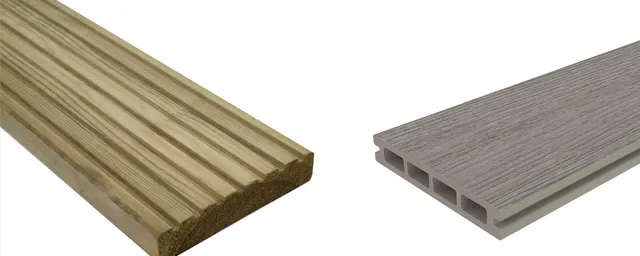What’s better, timber or composite decking?
Timber vs. Composite Decking - When it comes to creating the perfect outdoor space, one of the most crucial decisions you'll face is choosing the right material for your deck. Traditionally, timber has been the go-to option, but in recent years, composite decking has gained popularity. Both materials offer distinct advantages and disadvantages, making the decision a matter of personal preference, budget, and long-term goals. Let’s explore the key factors to consider when deciding between timber and composite decking.

Material Composition
Timber: Timber decking is typically made from natural wood, such as cedar, redwood, or pressure-treated pine. Each type of wood offers unique aesthetics and characteristics.
Composite: Composite decking is a blend of wood fibres and recycled plastic materials, also known as WPC (Wood Plastic composite). This combination results in a durable and low-maintenance alternative to traditional wood decking.
Aesthetics
Timber: One of the primary appeals of timber decking is its natural beauty and warmth. Timber decks age gracefully, developing a patina that adds character over time. The variety of wood species also allows for customization to match different architectural styles. We keep grooved premium redwood in stock in a range of lengths.
Composite: Composite decking comes in a wide range of colours, textures, and finishes, mimicking the look of natural wood without the maintenance requirements. While some may prefer the authenticity of timber, others appreciate the consistency and modern appeal of composite decking.
Durability and Maintenance
Timber: While timber decking can last for decades with proper maintenance, it requires regular upkeep, including staining, sealing, and occasional repairs to prevent rot, decay, and insect infestation. Exposure to the elements can cause fading, warping, and splintering over time.
Composite: Composite decking is renowned for its durability and resistance to rot, mould, and pests. Unlike timber, composite decking does not require staining, sealing, or painting. Routine cleaning with soap and water is typically all that's needed to keep it looking its best.
Cost
Timber: The initial cost of timber decking may be lower than composite decking, especially for pressure-treated pine. However, factoring in long-term maintenance expenses, such as staining and repairs, timber decking can end up costing more over its lifespan.
Composite: Composite decking tends to have a higher upfront cost but can be more cost-effective in the long run due to its minimal maintenance requirements.
Environmental Impact
Timber: Responsibly sourced timber decking can be a sustainable choice, as wood is a renewable resource. However, concerns about deforestation and habitat destruction underscore the importance of choosing certified or reclaimed wood.
Composite: Composite decking often incorporates recycled materials, such as plastic bags and wood scraps, reducing reliance on virgin resources. Some composite decking brands prioritize eco-friendly manufacturing processes and offer products with high recycled content.
Choosing between timber and composite decking ultimately boils down to your priorities, budget, and lifestyle. Timber decking appeals to those who appreciate the natural beauty of wood and don't mind the upkeep, while composite decking suits individuals seeking a low-maintenance and long-lasting solution. By weighing the pros and cons of each material and considering factors like aesthetics, durability, cost, and environmental impact, you can make an informed decision to create the perfect outdoor oasis for years to come.
Take a look at our premium redwood timber decking boards, or browse our extensive range of composite decking.
For a quick comparison in prices and to see everything you would need to build either a timber or composite deck, try our decking calculator.